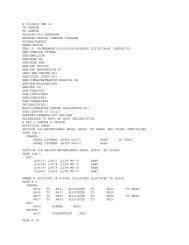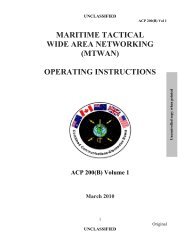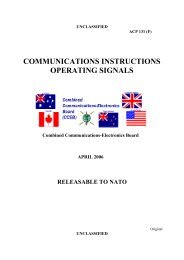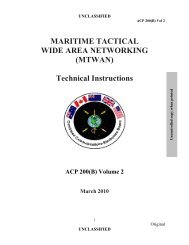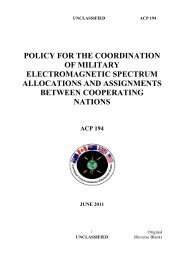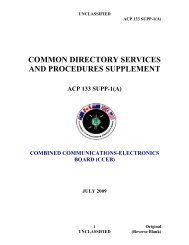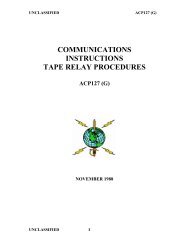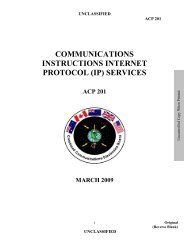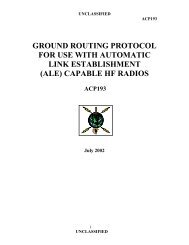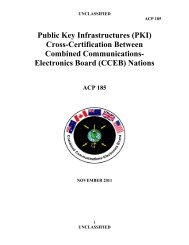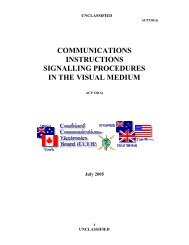communication instructions radio telegraph procedure
communication instructions radio telegraph procedure
communication instructions radio telegraph procedure
Create successful ePaper yourself
Turn your PDF publications into a flip-book with our unique Google optimized e-Paper software.
UNCLASSIFIED ACP124 (D)<br />
FIGURES<br />
1 . ---- 4 ….- 7 --… O -----<br />
2 ..--- 5 ….. 8 ---..<br />
3 …-- 6 -…. 9 ----.<br />
(NOTE: The figure zero is to be written with a slant superimposed unless the entire text consists<br />
entirely of figures. The letter Z may be written with a horizontal line superimposed in<br />
order to distinquish between 2 and Z. When this figure occurs in the text of messages<br />
which consist entirely of figures or in weather messages which use the number of code, it<br />
may be transmitted as "T" ("-"). On all other occasions the figure 0 is to be transmitted<br />
as "-----". Transmission of 0 as the letter "O" is expressly forbidden.)<br />
PUNCTUATION AND OTHER SIGNS<br />
BLOCK (capital letters or underline) ..--.- COMMA --..--<br />
FRACTION BAR (slant) -..-. QUESTION MARK ..--..<br />
PERIOD (full stop) .-.-.- COLON ---…<br />
HYPHEN or DASH -….- APOSTROPHE .----.<br />
PARENTHESIS ACCENTED e ..-..<br />
Left hand bracket -.--. ACCENTED a .--.-<br />
Right hand bracket -.--.- ACCENTED ä .-.-<br />
b. CHARACTER FORMULATIONS<br />
(1) A dot is used as the unit of duration<br />
(2) A dash is equal to three units<br />
(3) An element is either a dot or a dash<br />
(4) The space between elements is one unit<br />
(5) The space between characters is three units<br />
(6) The space between groups is seven units<br />
108. TRANSMISSION TECHNIQUES AND TRANSMISSION SPEEDS<br />
a. Each character shall be transmitted clearly and distinctly. The speed of transmission<br />
shall be governed by the prevailing conditions and the capability of the receiving operation(s).<br />
b. Accuracy in transmission is far more important than speed. The difference in time<br />
required to send a message at 18 words per minute and that required to transmit it at 25 words per<br />
minute is slight. Even this slight gain in time may be nullified by any added time required for repetitions.<br />
(1) The speed at which the receiving operator can copy without having to obtain<br />
repetitions is the speed at which the transmitting operator will transmit. When transmitting to more than<br />
one station in a net, the governing speed of the transmitting operator is that of the slowest receiving<br />
operator, but see (4) below.<br />
(2) The speed of transmitting headings on manually operated circuits should be<br />
slower than the speed of transmission of texts.<br />
UNCLASSIFIED 1-5



